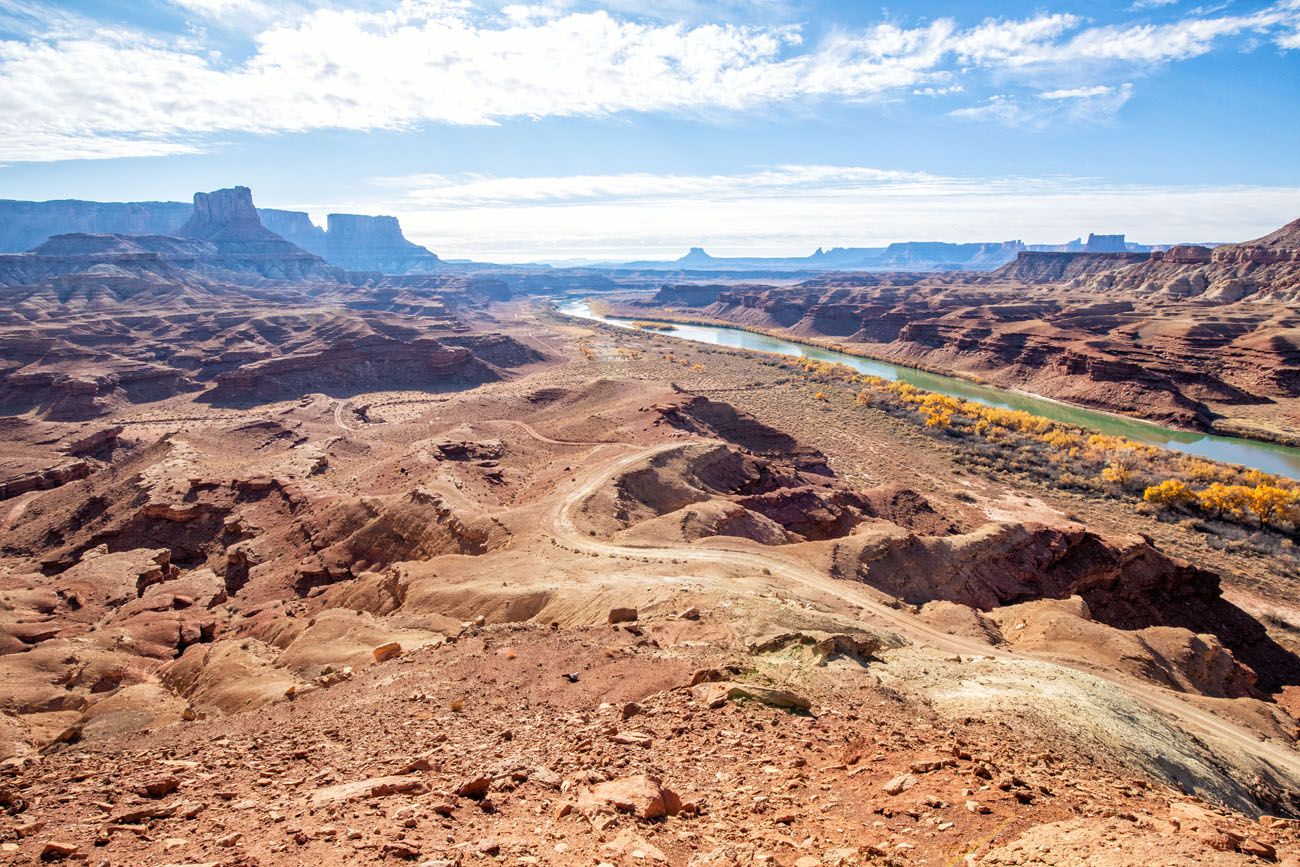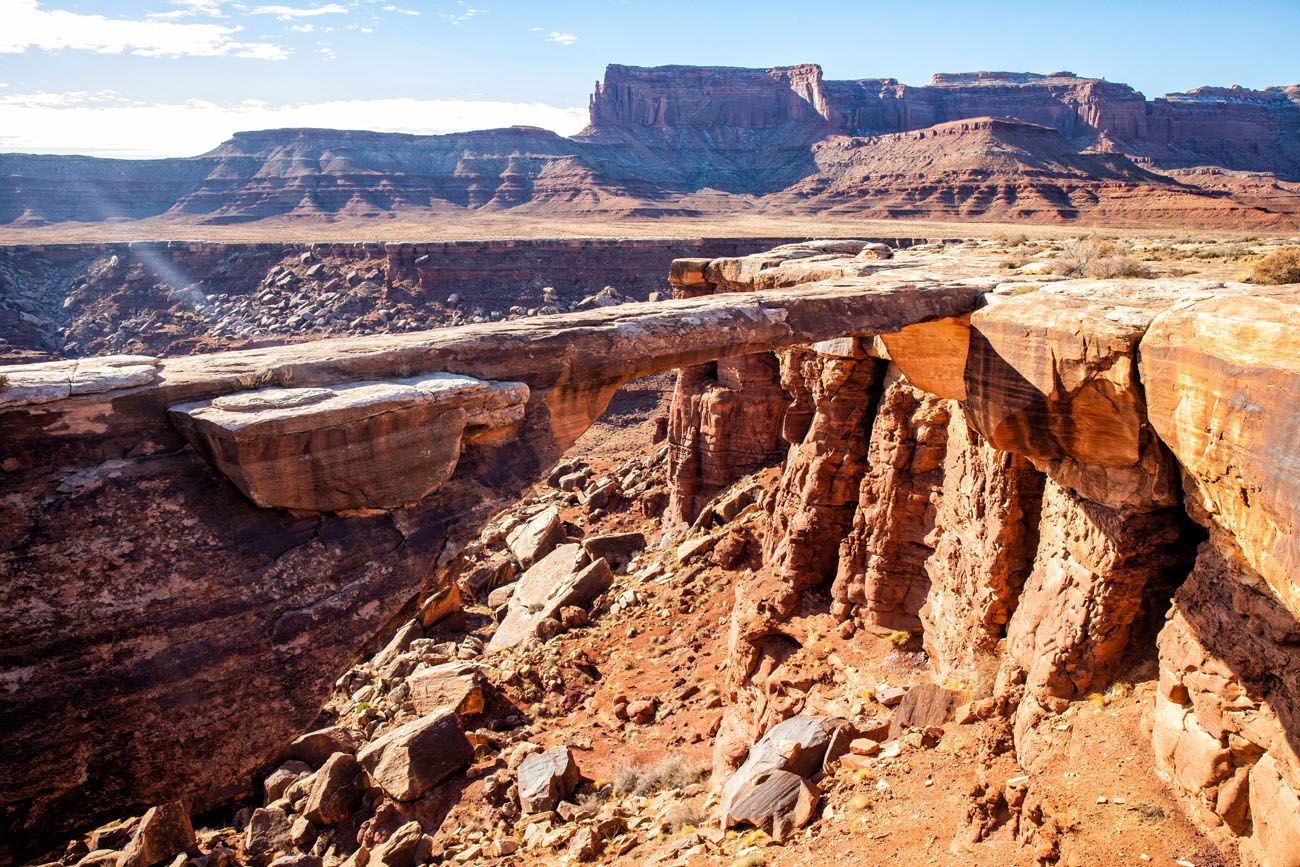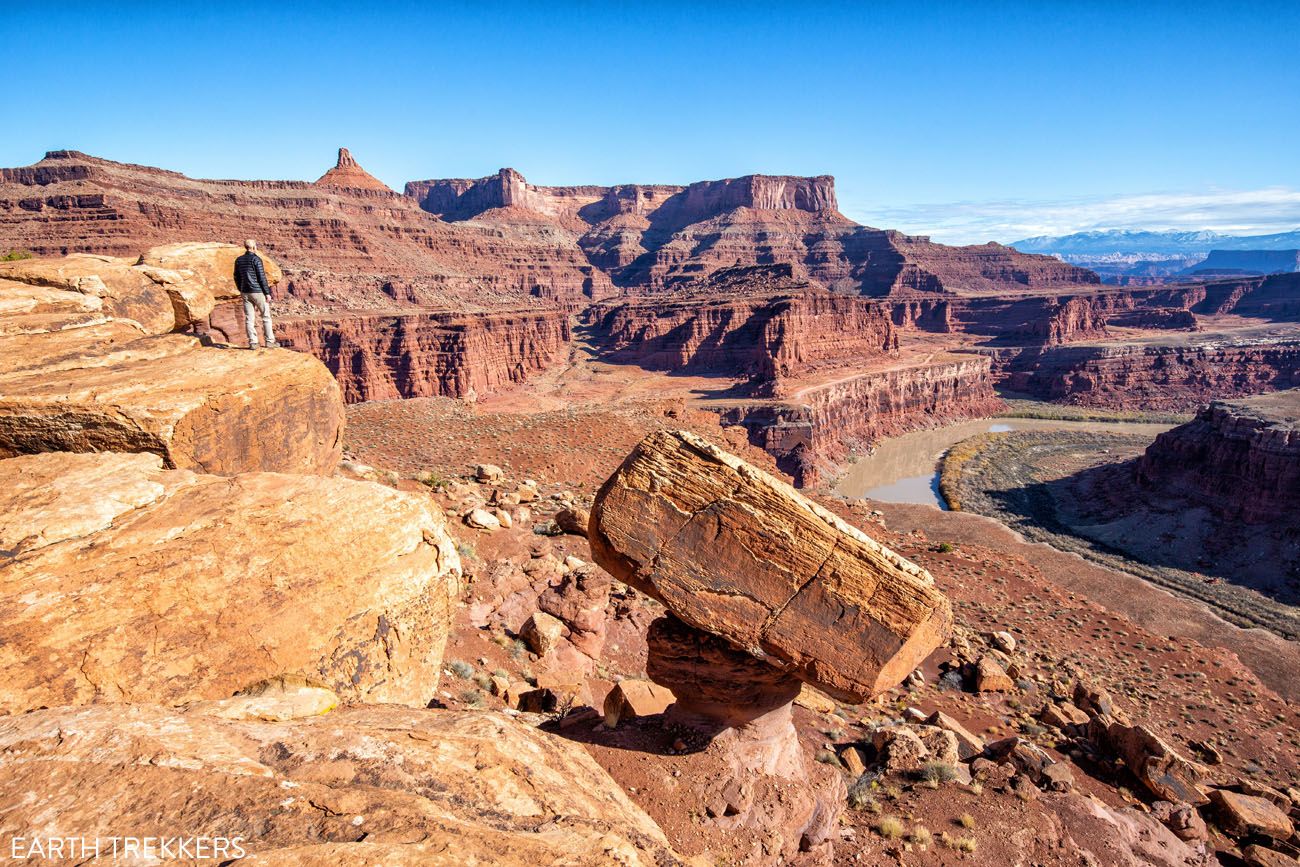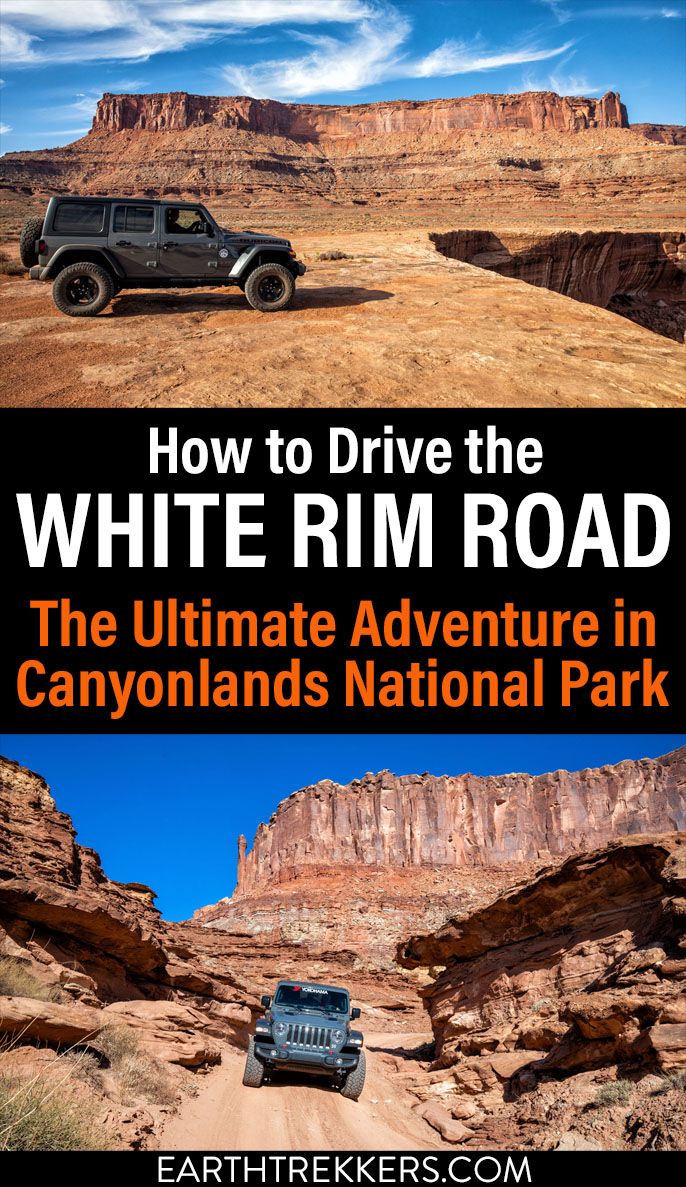Driving the White Rim Road is the experience of a lifetime. If you are looking for adventure, solitude, incredible views, and a totally different way to experience Canyonlands National Park, put this drive on your list.
Along the drive, you will gaze up at the Island in the Sky mesa and peer down into the canyons carved out by the Green River and Colorado River. You will drive along narrow cliff edges, past scenic overlooks, around towering buttes, and up and over rocky hills.
From your campsite, watch the sunset and gaze up into the night sky. If you are lucky enough to do this on a clear night, the view is spectacular. Canyonlands is a dark sky park and the number of stars you can see is astonishing.
From the White Rim Road, you have the option to go hiking or drive the short detour roads, if you want explore more of this remote landscape.
100 miles may sound like a long way to go, but there is never a boring moment on the White Rim Road.
The number of vehicles on the White Rim Road is limited, the campsites are spaced far apart, and you will drive for miles without seeing another person. This is a great way to escape the crowds and really get to know this national park.
We have so much information to share with you that it could not all fit into one article. In this article (part 1 of our two part series), learn about the driving route. Part 2 covers the planning and logistics for the White Rim Road).
Overview of the White Rim Road
Distance: 100 miles
Length of Time: 2 to 3 days is average. It can be done in one very long day during the summer season, when the days are long. For the best experience, we recommend spending at least night on the White Rim Road, so you can slow down and savor this journey.
Permits: A backcountry permit is necessary if you plan to spend more than one day, camping overnight along the White Rim Road. A day use permit is necessary if you plan to do this drive in one full day.
When to Go: You can do this drive all year. The best time is the spring and fall months when temperatures are mild.
Note: The driving distances in this article were taken from the odometer on our Jeep Rubicon.
Please practice the seven principles of Leave No Trace: plan ahead, stay on the trail, pack out what you bring, properly dispose of waste, leave areas as you found them, minimize campfire impacts, be considerate of others, and do not approach or feed wildlife.
Map of the White Rim Road

Clockwise or Counter-Clockwise?
The White Rim Road can be driven in either direction. Most people drive the White Rim Road in a clockwise direction, starting with the Shafer Trail Road.
We did the drive in a counter-clockwise direction because of the location of our campsite. Our campsite was Airport D, which is located 18 miles from the visitor center. We chose to drive the bulk of the loop on day 1, starting on Mineral Bottom Road, and driving 70 miles to the Airport campground. On day 2, we drove the detour road to Lathrop Canyon, drove up and down the Shafer switchbacks, and then returned to Moab on Potash Road.
How to Drive the White Rim Road: Counter-Clockwise Route
Below is the entire White Rim Road route in the counter-clockwise direction, from start to finish. Along the drive, we list the mile markers for campgrounds, detours, hiking trails, and viewpoints. We also highlight some of our favorite viewpoints along the drive.
If you plan to drive the White Rim Road in the clockwise direction, we provide driving distances to the same viewpoints, campgrounds, etc. at the end of this post.
Note: The distances of the detours (for example, the short drive to White Crack campsite) are not included in the overall distance of the White Rim Road.
0.0 Mineral Bottom Road
From Grand View Point Road, turn onto Mineral Bottom Road. Note: You will not enter the park. Mineral Bottom Road intersects Grand View Road before you get to the visitor center. If you have not already paid your Canyonlands entrance fee, or if you do not have an America the Beautiful Pass, you need to go the visitor center first to pay your fee.
Once you turn onto the dirt road, reset your trip odometer and follow along our mileage markers. Keep in mind that odometer measurements can vary between vehicles.
The first 13.1 miles, the distance between the start of the drive to the Mineral Canyon switchbacks, follows a well graded dirt road that slowly descends about 1,000 feet in elevation. There isn’t much to look at during this section of the drive. It’s also the fastest part of the entire drive, since the road is in great condition and it’s relatively flat.
13.1 Mineral Canyon Switchbacks

From the top of the Mineral Canyon Switchbacks you will descend another 1,000 feet but over a much shorter distance. This section of the drive is thrilling and a nice intro to the White Rim Road experience.
14.5 Bottom of the Mineral Canyon Switchbacks
At the bottom of the switchbacks, turn left at the junction onto White Rim Road. The road will now flatten out and will shortly begin to follow along the side of the Green River.

18.2 Canyonlands National Park
At this point you officially enter Canyonlands National Park.
20.5 Labyrinth Campground
21.2 Upheaval Dome Trailhead
Upheaval Dome is one of the longest and most difficult hikes to do in the Island of the Sky. From the White Rim Road, it is a 3.5 mile walk just to get to the hiking trail. If you plan to add this on to your drive along the White Rim Road, you will need most of the day to do it, since the hike from this point is roughly 15 miles long and very strenuous.
22.5 Hardscrabble Campground
This turnoff will lead to the Hardscrabble Bottom Campground. Unless you are camping here, continue on White Rim Road to begin your ascent up Hardscrabble Hill (about 400 feet of elevation gain). Note that this side of the hill does have some loose sand.


24.1 Fort Bottom Trailhead & Hardscrabble Hill
This short and easy hike (distance: 3 miles, time: 1 to 1.5 hours) leads to a viewpoint of the Green River. The cabin next to the river was built to hold patients who were being transported down the river to a tuberculosis center.

Fort Bottom Trail

From this viewpoint you can just barely see the cabin next to the Green River.
Tim and I liked this hike. It’s short, it’s fun, and the views are beautiful. However, if you are short on time (driving the White Rim Road in one day) I recommend skipping this hike to save some time.
This point is also the start of the descent down Hardscrabble Hill. This is one of the trickiest parts of the White Rim Road. Scout the view down the hill for oncoming cars. It’s easier to wait at the top than try to pass another vehicle on this stretch of road.




Almost at the bottom of Hardscrabble Hill
26.0 Bottom of Hardscrabble Hill & Potato Bottom Campground
Once past Hardscrabble Hill, the White Rim Road runs along the Green River. This portion of the road is noticeably rocky but it offers spectacular river views.

Potato Bottom

33.3 Holeman Canyon Viewpoint
This is your first opportunity to look down into one of the lower canyons. From here the road will become less rocky. Enjoy bouncing up and down as you ride over the little dirt hills and before the road turns rocky again.

36.4 Candlestick Campground & Viewpoint
This is another place to look down into a canyon.

As you continue on White Rim Road you will soon ascend another hill. This hill is smaller than the Hardscrabble Hill (about 200 feet of elevation gain). After the descent another lower canyon, called Soda Springs Basin, will open up on the right side. It will be tempting to stop right away to take a look, but as you drive around the canyon you will get better views.
39.6 Soda Springs Basin Viewpoint #1

40.6 Soda Springs Basin Viewpoint #2


42.5 Soda Springs Basin Viewpoint #3


Once you leave this viewpoint, you will begin the climb to the top of Murphy Hogback hill. The road will become more technical during this ascent and we recommend using 4WD here. It will start with an ascent of roughly 300 feet over the first mile, flatten out for about 1.8 miles, and then end with another ascent of roughly 420 feet over the final mile.
44.5 Soda Springs Basin Viewpoint #4
During the flatter section of the drive up Murphy Hogback you get a nice view over Soda Springs Basin.


The road to the top of Murphy Hogback
46.2 Top of Murphy Hogback & Murphy Hogback Campground
It’s a short, steep, narrow, and rocky drive down Murphy Hogback Hill.

47.6 Murphy Wash
The drive down Murphy Hogback hill ends at the Murphy Wash. You can hike the Murphy Trail from this point, a 7-mile out-and-back hike that climbs to the top of the Island in the Sky mesa.
51.0 Murphy Canyon Viewpoint

As you drive between this viewpoint and the junction for White Crack Road, you will overlook another basin called the Twins Basin. Look for the two pillars we referred to as “The Twins”.
53.7 White Crack Road Junction
This detour is a must see! The 1.4 mile road (one-way) is relatively easy to traverse, ending at the White Crack Campground. Park and walk along the white rocks to enjoy views out over the confluence of the Green River and Colorado River that rival those of the South Rim of the Grand Canyon. In the distance you can see the thin spires of the Canyonlands Needles district.

Looking south from White Crack. Off in the distance you can see The Needles district of Island in the Sky.

Looking east from White Crack
55.9 Monument Basin Viewpoint #1
This stop offers a great view of the Monument Basin Canyon. The Island in the Sky’s mesa with Grand View Point towers above you. For the remainder of the adventure you’ll now be looking out over the Colorado River.

57.4 Monument Basin Viewpoint #2
Stop here for another view of the canyon.


As you drive from this viewpoint to the Monster Tower viewpoint you will pass by two more canyons (Gooseberry Canyon and South Fork of Buck Canyon).

The trailhead for the Gooseberry hike. This hike is 5.4 miles round trip and takes you to the top of the Island in the Sky Mesa.
67.4 Monster Tower Viewpoint

69.0 Airport Tower Viewpoint

71.3 Airport Campground
About a half a mile beyond Airport Campground you will have a view into Lathrop Canyon.
72.1 Lathrop Canyon Road Junction
This detour will take you 4 miles one-way through Lathrop Canyon, ending at the Colorado River. It is a rough rocky descent that eventually gives way to a sandy track. Upon returning to the White Rim Road enjoy the mesa views above you.

The first part of Lathrop Canyon is the trickiest, with a rough road and a few tight switchbacks to get down into the canyon.

Colorado River

On the drive out of Lathrop Canyon
75.1 Little Bridge Canyon Viewpoint
This stop offers a view across the canyon with a mesa as the backdrop. 0.6 miles further offers a similar view but this time with a few pillars in the foreground.

78.6 Musselman Canyon Viewpoint

79.7 Musselman Arch
Turn right into the parking area at the posted sign. It is a short walk to the arch. Note: do not stand on the arch.

80.0 Colorado River Overlook
Turn right at the posted sign and follow the short but rough road to the overlook.

81.8 Gooseneck Overlook
Just beyond the posted sign for Gooseneck Overlook there is a pullout on the left for parking. It is a 0.3 mile walk to the overlook. The overlook doesn’t allow you to see the full gooseneck of the Colorado River (you’ll need to go to Dead Horse Point in Dead Horse Point State Park to see that), but you still get a great view of one of the horseshoe bends that makes up the gooseneck.

From this viewpoint you can see the Colorado River, Dead Horse Point State Park, Potash Road, and the La Sal Mountains.

83.0 Potash Road & Shafer Trail Road Junction
Turning right onto Potash Road will take you back to Moab. This is a rough road that eventually gives way to pavement. But this adventure wouldn’t be complete without ascending Shafer Trail to the top of the Island in the Sky.
Despite being a dirt road, ascending the Shafer Trail switchbacks was one of the smoothest road sections of this adventure. There are plenty of pullouts to allow for an oncoming vehicle to pass. Just keep looking for vehicles and mountain bikers and be prepared to wait in one of the pullout areas to allow them to pass.

The view up Shafer Canyon and the top of the Island in the Sky mesa.


At the top of Shafer Canyon. In the valley, you can see the White Rim Road as it heads east.
86.4 Shafer Trail Viewpoint
Before you approach the top of the Shafer Trail there is a nice area to pull over on the right with dramatic views down.

88.0 The End!
You end at the main paved road that takes you into the Island of the Sky district of Canyonlands National Park. Turning left onto the paved road will take you into the park with the Visitor Center only one mile away. Turning right onto the paved road will take you towards Dead Horse Point State Park, Arches National Park, and Moab. Pavement never felt so smooth!
Note: If you start and end at the visitor center, the entire loop is 98.2 miles (not including the detours along the White Rim Road), according to our odometer. Some sources will list slightly longer distances, for a total of 100 miles.
Alternative Route Back to Moab
If you like the idea of returning to Moab on more gravel roads, you can take Potash Road back to Moab. To do this, you would have to drive back down the Shafer Canyon switchbacks then turn onto Potash Road. This route takes you under Dead Horse Point, along the Colorado River, and past Thelma and Louise Point. Learn more in our post about Shafer Canyon Road and Potash Road.
How to Drive the White Rim Road: Clockwise Route
If you plan to drive the White Rim Road in the clockwise direction, here are mile markers for the same detours, hiking trails and viewpoints we list above, only without the photos (or this post would be super long).
On Grand View Point Road, 1 mile before you reach the visitor center, turn left onto Shafer Trail (labeled as Shafer Canyon Road on Google Maps) which is a dirt road. Once you turn onto the dirt road, reset your trip odometer and follow our mile markers. Keep in mind that odometer measurements can vary between vehicles.
0.0 Your journey starts with the descent down the Shafer switchbacks. Despite being a dirt road, this is one of the smoothest road sections of this adventure. There are also plenty of pullouts as you descend to allow for oncoming vehicles to pass. Keep an eye out for oncoming vehicles and be prepared to wait in one of the pullout areas to allow them to pass.
1.6 Shafer Trail Viewpoint. Stop here for dramatic views of the Shafer switchbacks.
5.0 Potash Road and White Rim Road Junction. Turning left onto Potash Road will take you back to Moab. This is a rough road that eventually gives way to pavement. But this adventure is just beginning so head straight and follow the White Rim Road.
6.2 Gooseneck Overlook. Just before the posted sign for Gooseneck Overlook there is a pullout on the right for parking. It is a 0.3 mile walk to the overlook. The overlook doesn’t allow you to see the full gooseneck of the Colorado River (you’ll need to go to Dead Horse Point in Dead Horse Point State Park to see that), but you still get a great view of one of the horseshoe bends that makes up the gooseneck.
8.0 Colorado River Overlook. Turn left at the posted sign and follow the short but rough road to the overlook.
8.3 Musselman Arch. Turn left into the parking area at the posted sign. It is a short walk to the arch.
9.4 Musselman Canyon Viewpoint. This stop offers a view across the canyon with the La Sal Mountains as a backdrop.
12.3 Little Bridge Canyon Viewpoint. This stop offers a view across the canyon with a few pillars and a mesa as the backdrop.
15.9 Lathrop Canyon Road Junction. This detour will take you 4 miles one-way through Lathrop Canyon, ending at the Colorado River. It is a rough rocky descent that eventually gives way to a sandy track. Upon returning to White Rim Road enjoy the mesa views above you.
16.7 Airport Campground. As you continue onward you will pass the North Fork of Buck Canyon.
19.0 Airport Tower Viewpoint. You’ll need to look back to see the Airport Tower which will be towering above you.
20.6 Monster Tower Viewpoint. Look back to see Monster Tower, which will be towering above you. The Middle Fork of Buck Canyon is to your left. As you drive from this viewpoint to the Monument Basin viewpoints, you will pass by two more canyons, the South Fork of Buck Canyon and Gooseberry Canyon.
30.6 Monument Basin Viewpoint #1. Offers a view of Monument Basin Canyon.
32.1 Monument Basin Viewpoint #2. Offers another view of the canyon. The Island in the Sky’s Grand View Point will be towering above you.
34.3 White Crack Road Junction. This detour is a must see! The 1.4 mile road (one-way) is relatively easy to traverse, ending at the White Crack Campground. Park and walk along the white rocks to enjoy views out over the confluence of the Green River and Colorado River, that rival those of the South Rim of the Grand Canyon. In the distance you can see the thin spires of the Canyonlands Needles district.
37.0 Murphy Canyon Viewpoint. This viewpoint overlooks Murphy Canyon and the Twins Basin. Look for the two pillars we referred to as “The Twins.” For the remainder of the adventure you’ll now be looking out over the Green River.
40.4 Murphy Wash and the beginning of the Murphy Hogback ascent
41.8 Top of the Murphy Hogback ascent and Murphy Hogback campground
43.5 Soda Springs Basin Viewpoint #1. During the flatter section of the Murphy Hogback descent you have a great view over Soda Springs Basin.
45.5 Soda Springs Basin Viewpoint #2. This viewpoint marks bottom of the drive down Murphy Hogback.
47.4 Soda Springs Basin Viewpoint #3
48.4 Soda Springs Basin Viewpoint #4
51.6 Candlestick Campground and Viewpoint. From here the road become less rocky. Enjoy bouncing up and down as you ride over the little dirt hills and before the road becomes rocky again.
54.7 Holeman Canyon Viewpoint. The road travels alongside the Green River and offers spectacular river views. This portion of the road is noticeably rocky.
62.0 Potato Bottom Campground and the start of the Hardscrabble Hill ascent
63.9 Top of Hardscrabble Hill and Fort Bottom Trailhead
65.5 Hardscrabble Campground
66.8 Upheaval Dome Trailhead
67.5 Labyrinth Campground
69.8 Leaving Canyonlands National Park
73.5 Junction for Mineral Bottom Road. Here the White Rim Road ends and you turn right onto Mineral Bottom Road to begin the ascent up the Mineral Canyon Switchbacks.
74.9 Top of the Mineral Canyon Switchbacks. From here the last 13.1 miles follows a well graded dirt road. There isn’t much to see during this final section of the drive.
88.0 (91.6) The End! You end at the main paved road that takes you into the Island of the Sky district of Canyonlands National Park. Turning right onto the paved road will take you into the park with the Visitor Center 9.2 miles away. Turning left onto the paved road will take you towards Arches National Park and Moab.
About Our Experience
We did this drive on November 12 and 13, 2020. It was colder than average for this time of year, with a high temperature in the mid to high-30’s. At night, it got down to 20 degrees Fahrenheit.
We also had limited daylight. Sunrise was at 7 am and sunset was at 5:10 pm. On our first day, we had to drive 70 miles on the White Rim Road to reach our campground (Airport D). We started the drive at sunrise to give us the full ten hours of daylight to reach our campsite. Along the drive, we kept our stops as short as possible. It felt a bit rushed, but we preferred to do the longer portion of the drive on our first day. On day 2, we had plenty of time to drive the detour to Lathrop Canyon and then take Potash Road back to Moab.
Continue to Part 2, the White Rim Road Planning Guide. Or, if you have limited time, learn how to drive the White Rim Road in one day in this post.
If you have any questions about how to drive the White Rim Road, or if you want to share your experience, let us know in the comment section below.
More Information about Utah
UTAH: To read all of our articles about Utah, check out our Utah Travel Guide.
CANYONLANDS: Check out our Canyonlands National Park Travel Guide for important travel planning tips, sample itineraries, advice on when to go, where to stay, and more.
ISLAND IN THE SKY, CANYONLANDS: The Island in the Sky district is the most popular area of Canyonlands to visit. Learn how to spend one perfect day at Island in the Sky and how to hike the Syncline Loop and Gooseberry Trail.
THE NEEDLES, CANYONLANDS: The Needles is a less visited area of Canyonlands but the hiking is spectacular. Learn what there is to do in the Needles and how to hike the Chesler Park Loop, one of the best hikes in Utah.
ARCHES, CANYONLANDS, & CAPITOL REEF: On this 10 day itinerary, take your time and explore three national parks in Utah plus a few off the beaten path destinations.
ARCHES NATIONAL PARK: If you are short on time, check out our One Day in Arches National Park to learn the best way to spend your time here.
NATIONAL PARKS: In our Guide to the US National Parks, get the full list of national parks with important travel planning information, such as things to do in the parks and sample itineraries.
If this is part of a bigger road trip through the USA, visit our United States Travel Guide for more inspiration and travel planning tips.
All rights reserved © Earth Trekkers. Republishing this article and/or any of its contents (text, photography, etc.), in whole or in part, is strictly prohibited.






Comments 34